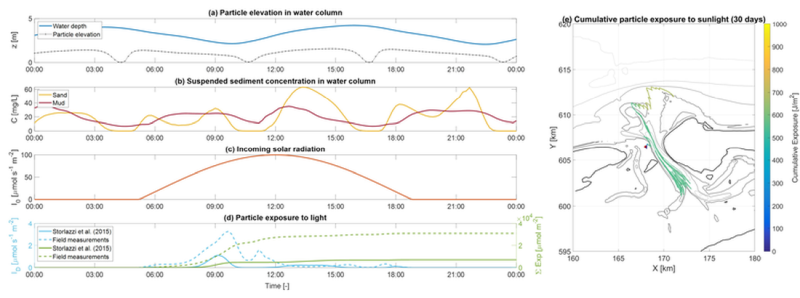N. Pannozzo1*, S.G. Pearson1, A.-M. de Boer2, T.J. Kooistra3, B.C. Van Prooijen1, J. Wallinga2
1Delft University of Technology, Netherlands; 2Wageningen University & Research, Netherlands; 3Royal Netherlands Institute for Sea Research, Netherlands
* Corresponding author: N.Pannozzo@tudelft.nl
Introduction
Quantifying sediment transport history is crucial for thoroughly understanding coastal systems and accurately designing coastal management interventions (e.g., nourishments). Luminescence, which is the ability of a mineral to store energy when buried and release it again upon exposure to sunlight, can be exploited as a sediment tracing tool in coastal settings, fulfilling the ongoing necessity to track sediment sources and pathways over a broad range of spatial and time scales. By quantifying residual luminescence, it is possible to determine how well-bleached mineral grains were before they were buried, thus yielding information on sediment sources and transport pathways.
Objective and Methods
This study aims to develop a numerical model that quantifies the relationship between residual luminescence of sand grains and their sources and transport pathways in coastal settings, with the ultimate goal of providing a framework to quantitatively infer provenance and transport history of coastal sediments from luminescence measurements. The model derives relationships between suspended sediment concentration (SSC) and light attenuation as a function of water depth to quantify the exposure of a given sand particle to sunlight (Storlazzi et al., 2015) and it couples with the numerical sediment particle tracking model SedTRAILS (Pearson et al., 2021) to compute the cumulative sunlight exposure of such particle (Figure 1). Combined with information on bleaching of luminescence signals as a function of light exposure, this allows to ultimately estimate residual luminescence as a function of sand grains source and transport pathways.
Results
Results from measurements conducted in the Dutch Wadden Sea are used to validate the performance of the model. The employment of the relationships provided by Storlazzi et al. (2015) for the quantification of particle exposure to sunlight is validated using relationships derived from field measurements of SSC and light attenuation across the water column performed within the Ameland Inlet (Figure 1d). The overall performance of the model in estimating cumulative sunlight exposure for a sand particle is then validated through a bleaching experiment performed at the same location. The model will be applied for the first time to investigate the fate of nourished sand in the Ameland Inlet.

Figure 1. Sand grain exposure to sunlight quantified through relationships between suspended sediment concentration and light attenuation as a function of water depth.
References
Pearson S.G., Elias E.P.L., van Ormondt M., Roelvink F.E., Lambregts P.M., Wang Z. & van Prooijen B. (2021). Lagrangian sediment transport modelling as a tool for investigating coastal connectivity. Coastal Dynamics Conference 2021 Delft University of Technology.
Storlazzi C.D., Norris B.K. & Rosenberger K.J. (2015). The influence of grain size, grain color, and suspended-sediment concentration on light attenuation: Why fine-grained terrestrial sediment is bad for coral reef ecosystems. Coral Reefs, 34 (3), 967-975.


